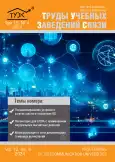Approach to Video Stream Quality Requirements Justification for FPV Control of Unmanned Systems
- Authors: Berezkin A.A.1, Vivchar R.M.1, Kirichek R.V.1
-
Affiliations:
- The Bonch-Bruevich Saint Petersburg State University of Telecommunications
- Issue: Vol 10, No 4 (2024)
- Pages: 7-15
- Section: ELECTRONICS, PHOTONICS, INSTRUMENTATION AND COMMUNICATIONS
- URL: https://journals.rcsi.science/1813-324X/article/view/263504
- EDN: https://elibrary.ru/JQQCXK
- ID: 263504
Cite item
Full Text
Abstract
About the authors
A. A. Berezkin
The Bonch-Bruevich Saint Petersburg State University of Telecommunications
Email: berezkin.aa@sut.ru
ORCID iD: 0000-0002-1748-8642
SPIN-code: 5730-6084
R. M. Vivchar
The Bonch-Bruevich Saint Petersburg State University of Telecommunications
Email: vivchar.rm@sut.ru
ORCID iD: 0000-0003-3865-9102
SPIN-code: 7493-6643
R. V. Kirichek
The Bonch-Bruevich Saint Petersburg State University of Telecommunications
Email: kirichek@sut.ru
ORCID iD: 0000-0002-8781-6840
SPIN-code: 3253-4972
References
- Гриценко А.А. Гибридные радиосети, или Третья технологическая волна в развитии спутниковых систем // Connect. 2023. № 11-12. С. 48‒53.
- Тихвинский В., Стрелец М. Перспективы создания спутникового сегмента 5G // Первая миля. 2018. № 1(70). С. 16‒25. doi: 10.22184/2070-8963.2018.70.1.16.25. EDN:YRTPCM
- Березкин А.А., Вивчарь Р.М., Слепнев А.В., Киричек Р.В., Захаров А.А. Метод сжатия видеопотока при управлении беспилотными системами в гибридных орбитально-наземных сетях связи // Электросвязь. 2023. № 10. С. 48‒56. doi: 10.34832/ELSV.2023.47.10.007. EDN:HRBGLL
- Матарас А.А., Гуляев И.Ю. Анализ применения FPV дронов в ходе боевых действий 2014-2023 гг. // Актуальные вопросы повышения эффективной огневой подготовки в силовых структурах: теория и практика (III Макаровские чтения), Пермь, Россия, 23 мая 2023: всероссийский сборник научно-практических материалов. Пермь: Пермский военный институт войск национальной гвардии Российской Федерации, 2023. Т. 3. С. 135–141. EDN:XCNJAX
- Kumar P., Parmar A. Versatile Approaches for Medical Image Compression: A Review // Procedia Computer Science. 2020. Vol. 167. PP. 1380–1389.doi: 10.1016/j.procs.2020.03.349
- Старовойтов В.В. Уточнение индекса SSIM структурного сходства изображений // Информатика. 2018. Т. 15. № 3. С. 41–55. EDN:XZOOHR
- Березкин А.А., Вивчарь Р.М., Киричек Р.В. Модель системы управления мобильными роботизированными комплексами различного назначения // Электросвязь. 2023. № 8. С. 12–18. doi: 10.34832/ELSV.2023.45.8.002. EDN:XXOJNM
- Звягин В.И., Птушкин А.И., Трудов А.В. Риск как одно из свойств качества решений, принимаемых в условиях неопределенности // Надежность. 2018. Т. 18. № 4(67). С. 45‒50. EDN:VNPHJG
- ГОСТ Р ИСО 11231-2013 Менеджмент риска. Вероятностная оценка риска на примере космических систем. М.: Стандартинформ, 2014.
- NASA/SP-2011-3421 (12/2011) Probabilistic Risk Assessment Procedures Guide for NASA Managers and Practitioners NASA.
- NetDisturb // ZTI Communications. URL: https://www.zti-communications.com/netdisturb (дата обращения 08.07.2024)
- Поршенев С.В. Копосов А.С. Использование аппроксимации Розенблатта-Парзена для восстановления функции распределения непрерывной случайной величины с ограниченным одномодальным законом распределения // Политематический сетевой электронный научный журнал Кубанского государственного аграрного университета. 2013. № 92. С. 1–27. EDN:RNEGGN
- Маслаков М.Л., Терновая А.К. Построение плотности распределения вероятностей КАМ сигналов // Цифровая обработка сигналов. 2021. № 3. С. 36–40. EDN:FIACYQ
- Березкин А.А., Вивчарь Р.М., Киричек Р.В. Многокритериальная оценка эффективности управления беспилотными системами в гибридных сетях связи // Труды учебных заведений связи. Т. 10. № 1. 2024. С. 18–25. doi: 10.31854/1813-324X-2024-10-1-18-25. EDN:VLZDQC
Supplementary files






